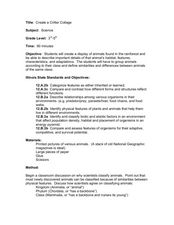Curated OER
Animal Farm: Chapter 3
In this Animal Farm comprehension check worksheet, learners respond to 5 short answer questions and define 5 terms pertaining to chapter 3 of Animal Farm by George Orwell in order to help them better understand the novel.
Curated OER
Animal Feeding Strategies
How do different animals eat? This cross-curricular worksheet has biologists describing types of eaters and giving examples. Eight short-answer questions prompt learners to identify a carnivore, herbivore, omnivore, insectivore,...
Curated OER
Animated Video Productions - Life Cycles
Seventh graders compare/contrast the life cycles of free-living organisms to that of parasites. They conduct Internet research, illustrate the stages of a specific organisms's life cycle, and direct and produce a mini-video production.
Scholastic
Study Jams: Symbiosis
Three types of symbiosis are explained: parasitism, commensalism, and mutualism. This is done with colorful animation and lively dialogue in a straightforward and easy-to-follow manner. Have your ecology class watch this at home and then...
Curated OER
Animal Diseases
Many of the toxins and parasites that cause illness are specified and discussed in this slideshow. Poisoning and other mechanisms by which an animal can fall ill are detailed and the information about frequency, prevention and treatment...
Curated OER
Create a Critter Collage
Students create a collage. In this animal classification instructional activity, students discuss why and how scientists classify animals. Students view pictures of different animals and decide which class each animal belongs to....
Busch Gardens
Create an Invertebrate
What better way for young biologists to learn about invertebrates than by creating their very own? Here, students are assigned a set of invertebrate characteristics and are asked to invent an imaginary ocean animal and a separate...
Education Outside
Creature Jeopardy!
After conducting research on a given scientific animal name, group members take a walk around their school and look for the specified animals in that classification. Then, they come back to their worksheets and create five creative clues...
Curated OER
Create a New Animal
Students understand what physical adaptations are and how they help an animal to survive. In this adaptations lesson, students research four animals and then make an original animal that has adaptations to make them survive.
Curated OER
Open Inquiry Using C. elegans
Ever wondered what motivates a roundworm? Introduce your biology class to C. elegans, a non-parasitic model organism that can help them understand behavioral stimuli. Paired pupils design an experiment to test the worm's reaction to...
Curated OER
The Power of the Environment in Our Lives
Students participate in a series of activities designed to demonstrate the differences between symbiotic and parasitic relationships. They discuss the differences and catergorize man's relationship with nature.
Curated OER
Trials of Life: Living Together
For this trials for life worksheet, students fill in the charts as they watch a video. Students identify the types of symbiosis as mutualism, commensalism, parasitism, or predator-prey relationship.
Curated OER
Symbiosis: Help, Hinder or Destroy
Use background information and vocabulary to familiarize your students with the concept of symbiosis and the role agriculture plays in the shared relationship. They then write the vocabulary in their lab books or journals, and read the...
Curated OER
Animal Feeding Strategies
In this food web study worksheet, students record how 24 animals get their food. Each animal should categorized as a forager, grazer, filter feeder, parasite, predator, or scavenger on the graphic organizer.
Curated OER
Ecology: Factors Influencing Animal Populations
Students assess the factors affecting animal populations. Working in groups they define specific vocabulary terms and complete several activities from "Project Wild."
American Museum of Natural History
What's This? Leeches
Who actually likes leeches? Meet a scientist that makes his living letting leeches feed on him. Pupils learn about the characteristics of leeches and different variations of the species. The lesson works as a remote learning resource or...
American Museum of Natural History
Life in the City
Believe it or not, biodiversity exists even in areas of disturbed habitat. An interactive activity challenges learners to look for species with a magnifying lens in an image of a city habitat. Pop-up images and descriptions explain how...
Curated OER
Sponges, Cnidarians, Flatworms, and Roundworms
In this simple animals worksheet, students read information about sponges, cnidarians, flatworms, and roundworms and then complete a chart comparing and contrasting these groups of animals. This worksheet has 11 fill in the blank questions.
Curated OER
Fish Hazards
Students study the Pacific salmon and see the different challenges they face. In this environment lesson students complete several activities that show how humans have affected the salmon environment. These activities have varying...
Curated OER
Raven Chapter 54 Guided Notes: Community Ecology
Providing a sweeping overview of population and community interactions, this ecology instructional activity gets learners thinking. They differentiate between habitat and niche, describe and give exemplars of various animal and plant...
Biology Junction
Protists: The World of Protists
More than 200,000 species of protists exist, living on land and in water around the planet. Scholars view the diversity of protists in an interesting presentation. It divides protists into three groups: animal-like protists, plant-like...
Curated OER
Roundworms
In this roundworms instructional activity, students will review the characteristics of roundworms including the common parasitic roundworms that infect humans. This instructional activity has 6 short answer and 2 fill in the blank...
Curated OER
Specialized Structures and Environment
Fifth graders read about how different animals protect themselves, and how characteristics give animals an advantage in their environment. Students then discuss a variety of "outer" wear for humans, and what they might choose to wear in...
Curated OER
Cats
Students participate in an after school program that promotes communication with others, solving problems, and making decisions. They experience getting in touch with themselves, about cats, training cats, showing cats and explore...

























